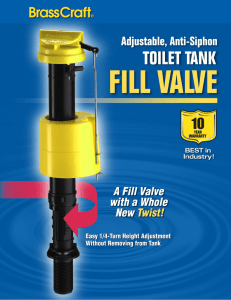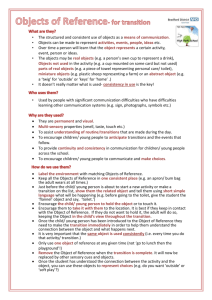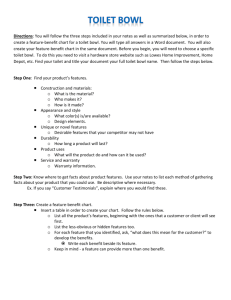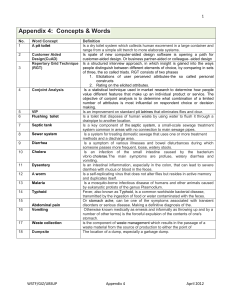here - Town of Ahoskie
advertisement
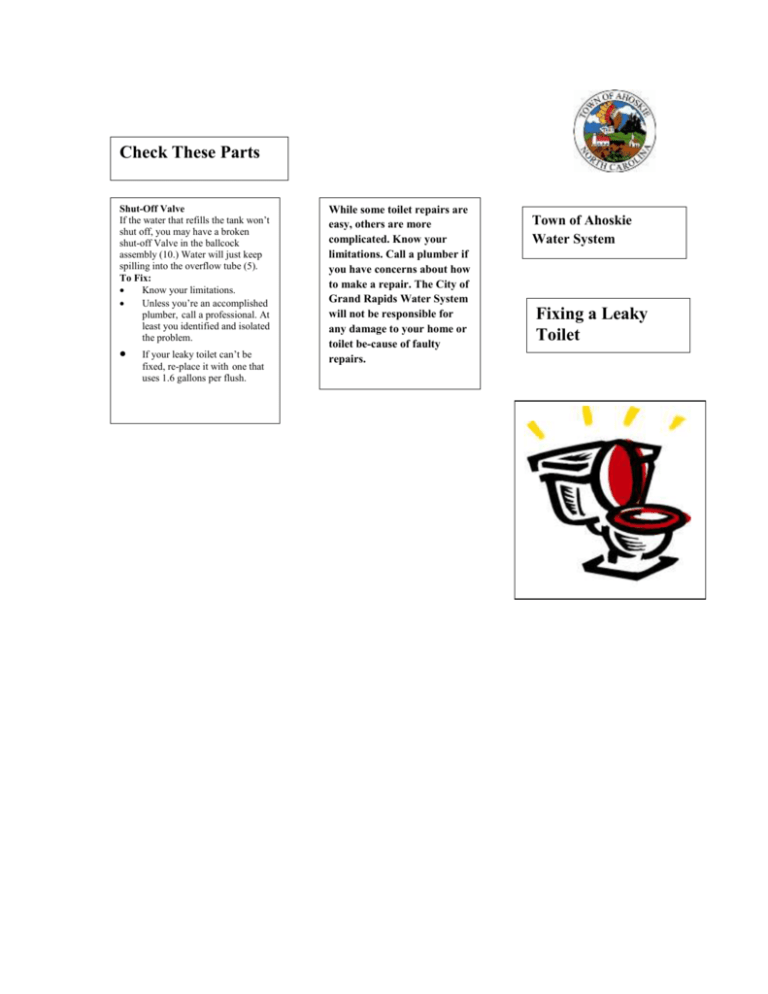
Check These Parts Shut-Off Valve If the water that refills the tank won’t shut off, you may have a broken shut-off Valve in the ballcock assembly (10.) Water will just keep spilling into the overflow tube (5). To Fix: Know your limitations. Unless you’re an accomplished plumber, call a professional. At least you identified and isolated the problem. If your leaky toilet can’t be fixed, re-place it with one that uses 1.6 gallons per flush. While some toilet repairs are easy, others are more complicated. Know your limitations. Call a plumber if you have concerns about how to make a repair. The City of Grand Rapids Water System will not be responsible for any damage to your home or toilet be-cause of faulty repairs. Town of Ahoskie Water System Fixing a Leaky Toilet Getting Started Check These Parts Locating a leak is a process of elimination. Shut off one toilet at a time at the wall. In between each shutoff, go to the water meter and check your flow indicator. If the small triangle stopped moving, that means the toilet is the culprit. If the small, red flow-indicator triangle is moving, that toilet is not the problem. Something else is causing the water flow. Before attempting to fix toilet leaks • Turn off the water at the toilet’s base (1). • Flush until your toilet tank is empty. • Soak up excess water in the tank with a sponge, and then check the following parts: Once a year, test your toilet for leaks • Remove the tank’s cover carefully. • Drop leak dye tablets or 5-6 drops of food coloring into the tank. • Wait several minutes. • If the bowl has color, you have a leak. Check These Parts Chain If you have to jiggle the handle to keep the toilet from running, it may be a misaligned flapper valve (2), loose handle (9), or an incorrect length of chain (4). To Fix: Clean and adjust the chain (4). If it still runs tighten the nut that holds the toilet handle (9) to the tank. If that doesn’t work, the handle may need to be replaced. Overflow Tube If the water level in the tank is too high, it may spill into the overflow tube (5) continually, creating a large leak that is difficult to hear. The correct water level is about a half inch to one inch below the top of the overflow tube (5). Flapper or Flush Valve Your flapper valve (2) may not be seating properly on the valve seat (3), or it may need replacement. If you gently rub the valve and get streaks on your fingers, you should re-place the valve. To Fix: Check the valve seat (3) for corrosion and clean it if necessary. If the flapper valve (2) still won’t seat properly, check the chain (4). It may be misaligned. Adjust the chain (4) to make sure the flapper valve (2) falls easily into place. If the flapper valve (2) seems worn or in poor shape, try replacing it with the appropriate brand (mark the length of the chain and then take the old part with you). The instructions on how to replace flapper valve will be on packaging. To Fix: Bend the float arm (6) downward gently until the water fills to the proper level after you flush. Be sure to check the float arm is securely screwed in so that the Arm won’t rotate. If the water level is too low, you may not get an efficient flush. It may be that you’ll need to replace the float ball (7) if it has filled with water or replace the float ball shutoff valve (8).
